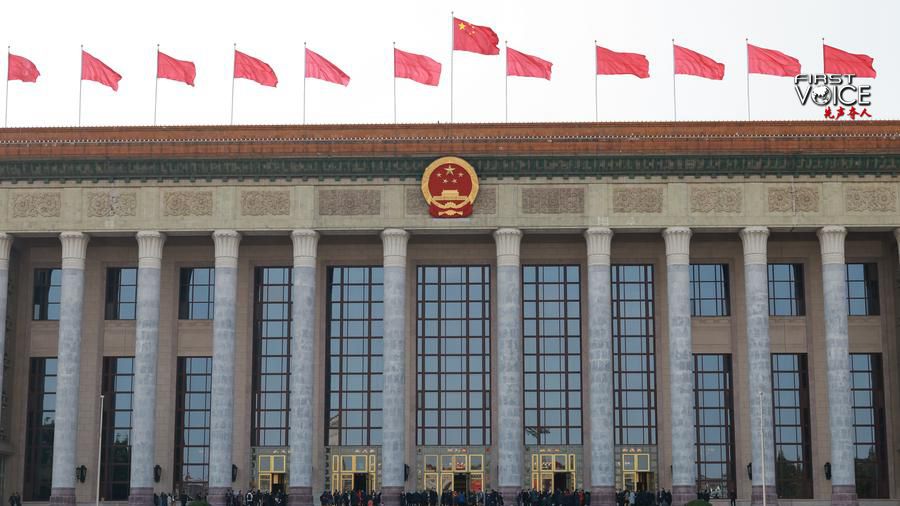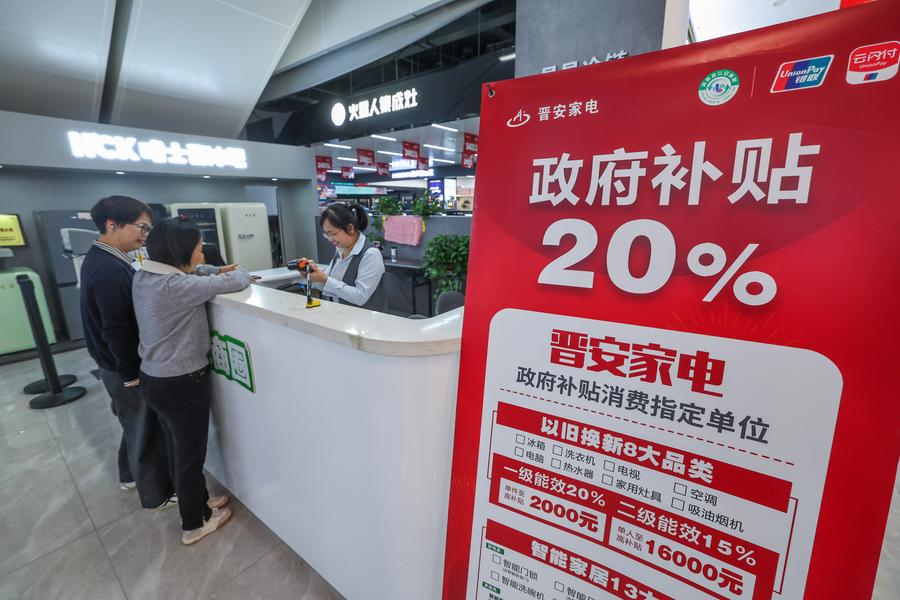
The Great Hall of the People in Beijing, capital of China. [Photo/Xinhua]
Editor's note: CGTN's First Voice provides instant commentary on breaking stories. The column clarifies emerging issues and better defines the news agenda, offering a Chinese perspective on the latest global events.
China targets economic growth of around 5 percent in 2025, according to the government work report submitted Wednesday to the national legislature for deliberation.
For economists, the figure, on a par with the past two years, is realistic. But some Western media outlets, again, have started to question China's capability of reaching the goal.
Reuters, for instance, warned that "An escalating trade war with U.S. President Donald Trump's administration is threatening to crimp China's economic jewel, its sprawling industrial complex, at a time when persistently sluggish household demand and the unraveling of the debt-laden property sector are leaving the economy increasingly vulnerable."
"Across-the-board tariffs imposed on Chinese products by U.S. President Donald Trump pose the latest threat to an economy already weighed down by a prolonged real estate slump and sluggish consumer spending and private business investment," said the Associated Press.
True, the Chinese economy faces some challenges, but the country has been taking concrete measures to expand domestic consumption, boost foreign investments and shift its economic structure.
Boosting consumption, investment and domestic demand is the No.1 focus on this year's government agenda. "Domestic demand will be made the main engine and anchor of economic growth," Wednesday's report said. For this end, China will launch special initiatives including issuing ultra-long special treasury bonds of 300 billion yuan ($42 billion) to support consumer goods trade-in programs.
With a population of over 1.4 billion and expanding middle-income group, China's consumption potential remains substantial. Vibrant consumer spending figures during the 2025 Spring Festival holiday tell. Sales revenues for household appliances and audiovisual equipment have surged by 166.4 percent compared to the 2024 holiday period, according to the State Taxation Administration.
The figures prove China's consumption momentum. A host of institutions attribute the improvement in the Chinese economy to its stronger domestic demand. A McKinsey report released earlier noted that China's "domestic consumption, though modest, is growing," denying allegations of a consumption crisis in the country.

Customers apply for trade-in subsidy from the government at a cashier in Fuyang, Hangzhou, east China's Zhejiang Province, October 31, 2024. [Photo/Xinhua]
Apart from domestic consumption, "innovation" is another keyword to transit from an export-led growth model. Thus, developing new quality productive forces also comes as a priority of this year's government agenda.
China aims to combine digital technologies including AI with manufacturing and market strengths, according to the report.
So far, China has built around 10,000 digitized workshops and smart factories, China Internet Development Report 2024 revealed. With AI's help, a handful of manufacturing enterprises in China's northeast region, known as the country's old industrial bases, have seen their production modernized and efficiency improved.
Take Harbin Electric Machinery Co. Ltd. in China's Heilongjiang Province as an example. The factory's magnetic pole welding robot workstation has boosted production efficiency by about 40 percent since it was launched in September last year, as Xinhua reported. In addition, robotic welding can tremendously enhance precision in operations and minimize workers' exposure to hazardous dust.
AI also means plummeting costs. Thanks to soaring production efficiency, mass production of commercial satellites costs about 45 percent less than traditional methods. Improved quality and dropped costs mean enhanced competitiveness of China-made products.
AI represents new quality productive forces that help shift the country's economic structure from one based on export, and this means reduced risks in the face of external challenges.
True, the U.S. is setting up trade barriers against China, but this has not thwarted the Chinese government's determination in expanding high-level opening up. No matter how the international landscape may evolve, China will not change its commitment in further expanding institutional opening up and taking unilateral opening-up measures to share its development opportunities with the world, according to Wednesday's report.
The country will further improve services for foreign companies, deepen market reforms, and upgrade free-trade zones. And its efforts have been recognized. "China's robust supply chain, favorable policies, dynamic innovation ecosystem and vast market potential provide significant advantages for our local operations here, much like for other multinational companies," Xinhua quoted Henry Ding, president of 3M China, as saying.
Admittedly, the Chinese economy faces some difficulties, but these cannot prevent the country's growth. "In the face of a challenging global environment, the proactive and resilient goal suggests that China is braving uncertainties with a clear, determined approach to growth," said Huang Qunhui, a national political advisor from the Institute of Economics of the Chinese Academy of Social Sciences.
Last year, China saw its GDP increase 5 percent year on year, ranking among the world's fastest-growing major economies. This year's target of 5 percent is not only realistic but also scientifically grounded.

 中文
中文



